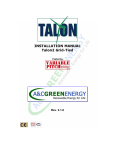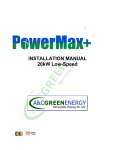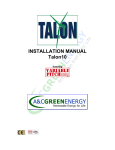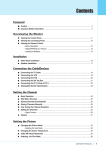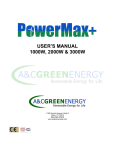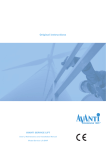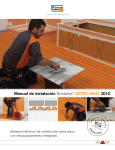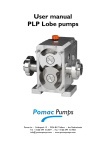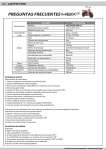Download INSTALLATION MANUAL Talon5 Grid-Tied
Transcript
INSTALLATION MANUAL Talon5 Grid-Tied Featuring Rev. 2.2.0 Talon 5 Installation Manual July 14, 2010 Table of Contents Contact information .........................................................................................................4 Statement ........................................................................................................................5 1. General........................................................................................................................6 1.1 Marking Illustrations ...........................................................................................6 2. Wind Generator Basics ...............................................................................................7 2.1 Grid-Tied Systems and Off-Grid Systems .............................................................7 2.2 Up wind Systems and Down Wind Systems..........................................................7 2.3 Fixed Pitch systems and Variable Pitch Systems..................................................7 3. TALON – The Downwind Variable Pitch System ........................................................8 3.1 Structure ................................................................................................................8 Fig. 13.2 Technical Specifications ...............................................................................8 3.2 Technical Specifications ........................................................................................9 3.3. Output Power and Performance Curves...............................................................9 3.4 Features...............................................................................................................10 3.4.1 Blades: ..........................................................................................................10 3.4.2 Generator: .....................................................................................................10 3.4.3 Variable Pitch Technology: ...........................................................................10 3.4.4 Other Features ..............................................................................................11 4. Safety Measurements ...............................................................................................11 5. Installation .................................................................................................................12 5.1 Preparation ..........................................................................................................12 5.2 Making the Foundation ........................................................................................12 5.3 Tower Assembly ..................................................................................................13 5.4 Generator Installation ..........................................................................................14 5.4.1 Generator Body Installation...........................................................................14 5.4.2 Blade Installation...........................................................................................15 5.4.3 Centrifugal Hammer Installation....................................................................15 5.4.4 Manual Shutdown System Installation ..........................................................16 5.4.5 Auto Shutdown System Installation (optional)...............................................18 5.5 Erecting the TALON.............................................................................................20 5.5.1 Inspection before Erecting the TALON .........................................................20 5.5.2 Erecting TALON with Crane..........................................................................21 5.5.3 Inspection of the Tower.................................................................................22 6. Electrical Wiring.........................................................................................................23 6.1 System Diagram ..................................................................................................23 6.2. Electronic Equipments Settings ..........................................................................23 6.3 Wiring Procedures ...............................................................................................24 7. Computer Monitoring System.................................................................................24 7.1 System Requirements .........................................................................................24 7.2 Features of the Monitoring System......................................................................24 7.3 Real Time Data Logging and Displaying .............................................................25 7.4 Screen Shots .......................................................................................................25 8. System Testing..........................................................................................................26 8.1 Inspection of the Electrical Wiring........................................................................26 8.2 System Testing ....................................................................................................27 2 A & C Green Energy Inc. © Copyright 2010 Talon 5 Installation Manual July 14, 2010 8.2.1 Basic Testing.................................................................................................27 8.2.2 Advanced Testing .........................................................................................28 9. User’s Manual ...........................................................................................................29 9.1 How to Shutdown and Start the System ..............................................................29 9.1.1 Starting the System.......................................................................................29 9.1.2 Manual Shutdown .........................................................................................29 9.2 User Routine Check.............................................................................................30 9.3 Maintenance ........................................................................................................30 9.3.1 Maintenance after 3 Months..........................................................................30 9.3.2 Checking After Heavy Winds ........................................................................31 9.3.3 Maintenance Every Year...............................................................................31 9.3.4 Maintenance Every Other Year.....................................................................32 10. Troubleshooting.......................................................................................................33 Appendix 1 Bolt Torque (Nm)......................................................................................... A Appendix 2 Mono Tower Foundation ............................................................................. B Appendix 3 On-Grid Wiring Diagram.............................................................................. C Appendix 4 Guide on Choosing the Electrical Cables.................................................... D Limited Warranty Information ......................................................................................... E Talon 5 Warranty Registration Card...............................................................................G 3 A & C Green Energy Inc. © Copyright 2010 Talon 5 Installation Manual July 14, 2010 Prior to installation and operation, it is important that you thoroughly read this manual to ensure proper installation and safety. Contact information 1108 Summit Ave., Suite 8 Plano, TX 75074 Tel: 866-WNDPWRD Fax: 972-516-0697 Web: www.acgreenenergy.com 4 A & C Green Energy Inc. © Copyright 2010 Talon 5 Installation Manual July 14, 2010 Statement A&C Green Energy is not responsible for any damage and/or injury caused under the following situations: * Damage caused by any incorrect installation * Damage caused by using unauthorized equipment * Damage caused by any incorrect operation * Damage caused by lightning, typhoon and other force majeure Note: 1. The off-grid installation manual is available on line at www.acgreenenergy.com or call A & C Green Energy, Inc. 2. To install the system correctly, sometimes a certified structural engineer and licensed electrician is necessary. 3. The annual power output from the system is determined by the local wind resources and some other factors, such as the installation elevation, temperature, system conditions, terrain and density of periphery buildings. 5 A & C Green Energy Inc. © Copyright 2010 Talon 5 Installation Manual July 14, 2010 1. General 1.1 Marking Illustrations Each sign below has its special meanings. It is mandatory for the installers and users to understand their meanings and act accordingly. Contact us if you need help. Warning: means there are risks that may cause personal injury or even death. Caution: means there are risks that may cause wind turbine, equipment or property damage. Advice: helpful installation & maintenance hints from the manufacturer. 6 A & C Green Energy Inc. © Copyright 2010 Talon 5 Installation Manual July 14, 2010 2. Wind Generator Basics 2.1 Grid-Tied Systems and Off-Grid Systems • Off-grid application: The electricity generated by the wind turbine can be stored into batteries. Through an off-grid inverter, the DC electricity can be changed into stable AC electricity for off-grid power supply. • On-grid application: The electricity generated by the wind turbine can be rectified into DC electricity. Through an on-grid inverter, the DC can be converted into stable AC and feed the local utility grid. 2.2 Up wind Systems and Down Wind Systems The terms Upwind and Downwind refer to the relation of the turbine blades to the pole. An upwind turbine orients the blades on the upwind side of the pole and vice-versa. An upwind turbine can have a tail or no tail. A downwind system has no tail. The blades naturally maintain their orientation on the downwind side of the pole no matter which direction the wind blows. 2.3 Fixed Pitch systems and Variable Pitch Systems • What is Variable Pitch Technology? This is an advanced method of regulating the rotor RPM by adjusting the blade’s attack angles based on the RPM. When the RPM goes higher, the attack angle will decrease so the rotor slows down. This system enables the wind turbine to maintain a constant peak output during times of high wind. • How does TALON Variable Pitch Technology work? The principle is using centrifugal force to make the blade rotate along its axis. Each of the Talon's 3 blades has an attached centrifugal hammer which acts when the generator reaches the rated RPM and causes the blade to rotate along its axis to reduce the attack angle. . • Why is Variable Pitch Technology important? The variable pitch system produces more energy than other systems simply because it will not shut down when the rated wind speed is reached as other wind turbines do. When the wind speed reaches 25mph, other systems begin to shut down. However, a variable pitch system keeps generating energy at the peak rate. This makes a significant difference in the total power generated. • What does all this mean? With the increased power output from the Talon wind turbine, you will have more energy to use and more energy bill savings. The better technology means a higher return on your investment. 7 A & C Green Energy Inc. © Copyright 2010 Talon 5 Installation Manual July 14, 2010 3. TALON – The Downwind Variable Pitch System 3.1 Structure The completely installed turbine is composed of variable pitch blades, permanent magnet generator (PMG), slip ring, tower, braking system, E-Load Box, inverter, etc. Fig. 1 8 A & C Green Energy Inc. © Copyright 2010 Talon 5 Installation Manual July 14, 2010 3.2 Technical Specifications TECHNICAL SPECIFICATIONS Blade Diameter Blade Material/Quantity Rated Power Maximum Power Rated Wind Speed Start-Up Wind Working speed Survival Wind Rated rpm Generator Type Speed Regulation Shut Down Method Generator Lifespan 18.37 feet FRP/3 5,000 W 5,400 W 24.6 mph 6.7 mph 9-56 mph 112 mph 240 3 phase AC PMG Variable Pitch Manual or Auto Shutdown 15 years Table 1 3.3. Output Power and Performance Curves Wind Speed (m/s) Wind Speed (mph) Output Power (W) kWh / Month 4 5 6 7 8 9 10 11 12 13 14 15 16 9 11 13 15 18 20 22 24 27 29 31 33 36 200 450 1250 1450 2130 3030 4120 5400 146 329 914 1059 1556 2213 3010 3945 9 A & C Green Energy Inc. © Copyright 2010 Talon 5 Installation Manual July 14, 2010 3.4 Features 3.4.1 Blades: With a high tip-speed ratio and a noise lower than 65db, the blades have been aerodynamically optimized for better performance. The blades have passed extensive wind tunnel tests. The co-efficiency of the blades is over 0.4. Made of the same material as the mega-watt wind generator systems, the special purpose gel-coat resin and reinforced FRP, each Talon blade set is highly durable and will guarantee safe operation under a wind speed of up to 56mph wind speed. 3.4.2 Generator: Features rare earth magnets, high temperature, enamel-coated magnet wire and top grade bearings, which make the generator’s efficiency greater than 90%. The generator reaches F-Grade insulation and IP54 protection standard, and is designed as maintenance free during its life time. The cast steel housing is galvanized and powder coated for long lasting life and harsh environment. 3.4.3 Variable Pitch Technology: All wind systems adopt some type of speed regulation method to avoid self-destruction. The megawatt systems pitch their blades to maximize the power output using automatic control systems. Most small wind systems use either tail furling or an electronic brake to control the RPM. However, both of these methods will significantly reduce the power output since they shut down the system at its rated RPM. The electronic brake may also cause the generator and electronics to burn out during extended high winds. TALON systems use centrifugal force to adjust the pitch angle of the three blades to regulate the RPM. It is a self adaptive process. When the rotor is static, the pitch angle is about 10 degrees. As the RPMs go higher, the centrifugal force becomes greater and starts to push the blades to reduce the pitch angle to slow down the rotor. On the contrary, when the wind slows down, the pitch angle increases to help raise the RPM. At about the rated wind speed, the system will reach a balance so the RPM begins to wave around the rated value until wind speed reaches 56mph. Therefore, the power generated will be significantly higher than the other speed regulation methods since the working range is much larger. Fig. 2 shows how this passive centrifugal variable pitch technology works. 10 A & C Green Energy Inc. © Copyright 2010 Talon 5 Installation Manual July 14, 2010 Fig. 2 When the wind speed is below 7 mph, the turbine blade angle remains static and the angle (X1) formed between the blade and turbine plane is B° (X1=B°). This is the ideal angle for the blades to begin their rotation. As long as the wind speed reaches 7 mph, the blades will begin to rotate. While rotating, the outermost edge of the blade will be driven by the centrifugal force generated by the rotation of the blade to tilt toward the turbine plane. As the wind speed increases, the blade angle (X1) will then decrease to 0° so that the blade is parallel with the turbine plane. At this angle, the turbine has nearly reached its rated output power. When the wind speed is between 20 mph - 55 mph, the blade angle (X1) will stay near 0° with slight fluctuations in order to maintain its rated power. When the wind speed is between 55 mph - 112 mph, the wind will draw the blade by the centrifugal force, so the angle (X1) will continue to decrease to a negative angle (X1 = -B°) [B° and -B° are not the same]. Under this negative angle, the blade angle will produce a resistance on the rotation of turbine blades to slow down the turbine, thus protecting it from over-speed operation. The maximum revolution of the turbine will be no more than 300 RPM. 3.4.4 Other Features The TALON adopts a downwind system design, which eliminates the tail. All the parts are galvanized and powder coated so they can last for years without rusting. 4. Safety Measurements 1. Do not allow the TALON to run without a load. A no-load condition may cause damage to generator itself or the blades. 2. Avoid allowing the system to run under high wind speed (>= 56mph) for an extended period of time. It is recommended (though not required) to shut down the wind turbine manually when the wind speed is over 56mph to protect the wind generator. 11 A & C Green Energy Inc. © Copyright 2010 Talon 5 Installation Manual July 14, 2010 3. Do not flip the switch on the E-Load Box to Manual Brake when the RPM is high. Only do it after the brake is manually applied so that the rotor slows down or does not spin. 4. Before disconnecting the E-Load Box from the generator, set the brake manually by pulling down and locking in the winch (lever). After disconnecting the E-Load box from the generator, short circuit the 3 wires from the generator. 5. Do not stand under running wind turbines during high winds. 6. If there is an unprecedented vibration or strange noise being detected during the turbine operation, stop TALON immediately for inspection. 7. When setting up the TALON, be sure to set the brake and that the 3 wires from the generator are short circuited until all the electronics are connected. When disassembling the TALON, please put the generator on brake and short circuit the 3 wires from the generator, then disconnect the electronics. (See appendix 3) 8. All electrical connections should strictly follow the NEC code. All electrical equipment and the generator pole need to be properly grounded according to NEC code. 5. Installation 5.1 Preparation 1. Check the parts against the packing list. If you encounter any packaging discrepancies, contact your Talon reseller immediately. 2. Keep all the parts and components away from water. 3. Prepare electrical cables based on the table in Appendix 4. Since the transport loss of AC is greater than DC’s, we recommend the E-Load Box be installed within 660 feet from the generator. If the distance is greater, please choose a thicker wire based on the table in Appendix 4. 4. The turbine should be installed when the wind speed is less than 18 mph. 5.2 Making the Foundation Notes: the foundation varies based on the soil conditions and location. The technical 12 A & C Green Energy Inc. © Copyright 2010 Talon 5 Installation Manual July 14, 2010 drawing in Appendix 2 only applies to an 8 meter tower on the soil conditions specified and a non-flooded area. Please contact A&C Green Energy, Inc for availability of technical drawings for your location or consult a local certified structural engineering firm for the appropriate foundation design. 1. Dig a 9’!9’ square hole that is 4’ deep 2. Make a rebar grid as shown in appendix 2. The quality of this grid is crucial to the strength of the tower base. Fix the bottom and top positioning plates onto the grid. Set the 12 anchor bolts through the 12 holes of the bottom and top positioning plates. Adjust the alignment to make sure the 12 anchor bolts are perpendicular to the positioning plates. 3. Put a 4” layer of concrete at the bottom of the hole and make it level. 4. Make a frame with inner dimensions of 9’X9’ using two layers of wood boards. Place the frame around the pit and set the rebar grid in the center of the pit. Make sure the positioning plates are level. 5. Make a 90 degree should be at the projected concrete and be connected duct tape. conduit and fix it onto the rebar grid. One end of the conduit center of the top positioning plate with 0.5-1” above the surface. The other end should come out of the side of the pit to the conduit in the ditch. Cover the conduit opening with 6. Pour the concrete. 7. Wait at least 100 hours to allow the concrete to cure. During this period do not touch it or attempt to install the wind turbine. 8. After the concrete has cured, remove the wood frame and fill the side of the concrete with soil and stone. Tamp it tight. 5.3 Tower Assembly 13 A & C Green Energy Inc. © Copyright 2010 Talon 5 Installation Manual July 14, 2010 1. Bolt the upper and lower tower sections together. Make sure the markings on the tower sections are aligned. 2. Place the connected tower with the tower bottom close to the foundation; put a bracket beneath the tower 1 " feet away from the tower top. 3. Using a steel wire, insert the electrical cable (3 leads) and the steel cable into the tower top and pull them out from bottom of the tower. Leave 18 inches outside the tower top. 5.4 Generator Installation 5.4.1 Generator Body Installation 1. Fix the patch board onto the top end of the tower. Connect the 3 leads of the electrical cable inside the tower onto the terminals on one side of the patch board. Connect the three leads of the electrical cable from the turbine to the 3 terminals on the other side of the patch board respectively. Short circuit the 3 leads of the electrical cable so the generator will not spin during the installation. 2. Bolt the vibration isolator onto the tower top by aligning the flange holes of the vibration isolator with the flange hole of the tower top. Tighten the 8 M16!60 inner hexagonal bolts (including the spring washer and flat washer). 3. Lift the wind turbine to align the bottom flange with the vibration isolator flange, bolt them up with eight M16!60 outer hexagonal bolts. 14 A & C Green Energy Inc. © Copyright 2010 Talon 5 Installation Manual July 14, 2010 Fig.2 Fig.3 5.4.2 Blade Installation 1. Lift the generator body, which has been connected to the tower with the hub facing sides or down. (Fig 4 and Fig 5) 2. Fix the three blades onto the hub with 12 M16X110 hexagon bolts. Please make sure the letters on the blades match the letters on the hub. Be sure to use flat washers, lock washers and nuts. The torque of the bolts must be 180~210Nm. Short circuit the 3 leads of the electrical cables to prevent the rotor from spinning. 5.4.3 Centrifugal Hammer Installation Hold the centrifugal hammer downward and fix it onto the blade hub one by one. Please refer to Fig. 8 for the correct positioning of the hammers. The four M12!20 hexagon bolts and spring washers are to be used for each hammer (Fig. 6, Fig. 7 and Fig. 8). 15 A & C Green Energy Inc. © Copyright 2010 Talon 5 Installation Manual July 14, 2010 The inappropriate installation of the centrifugal hammers will cause variable pitch failure, which will damage the system and may cause personal injuries. 5.4.4 Manual Shutdown System Installation The mechanism of shutting down the TALON wind generator is implemented by adjusting the blade pitch angle so that the rotor loses propelling power from the wind. The manual shutdown system includes a winch, the steel cable and the variable pitch blades. When the winch is applied, the cable pulls the blades to rotate along their axis to have a smaller attack angle so the rotor stops. When the winch is released, the spring pushes the blades back to their original orientation so the rotor can start rotating. 5.4.4.1 Installation Install the winch at the tower bottom with the provided bolts. Connect it with the steel cable from the turbine body. (Fig. 9 and Fig. 10) 16 A & C Green Energy Inc. © Copyright 2010 Talon 5 Installation Manual July 14, 2010 When installing the winch, adjust the cable tightness so that when it’s applied, the blades will pitch to the largest angle allowed. 5.4.4.1 Inspection of the Blade Pitch and Braking Mechanism The purpose of this step is to verify the blade pitch can be adjusted when the winch is tightened so the turbine will stop rotating, and when the winch is released, the blades return to the normal pitch angle so the rotor spins. 1. Check the tightness of the steel cable. When the winch is not applied, the steel cable is loose and the blades pitched at about B=10 degrees to catch the wind. When the winch is applied, the steel cable is tightened up and the blade pitch becomes B=-7 to -8 degrees with the rotation plane. See Fig. 2. 2. Manually tighten up and release the steel cable 2 or 3 times, verify the blade pitch angle changes accordingly. Make sure the winch can be held at the stop position with the positioning bolt. This step should be completed before the tower is erected. 17 A & C Green Energy Inc. © Copyright 2010 Talon 5 Installation Manual July 14, 2010 5.4.5 Auto Shutdown System Installation (optional) The automatic shutdown system adds an electric activator to the manual shutdown system to pull the steel cable instead of using a manual winch. 5.4.5.1 The System Components The auto braking system includes a braking controller, which is powered by a 12V rechargeable battery, an electric pushing rod, E-Load Box and a battery charger. The braking controller (top left corner of Fig 11) has two meters on its panel. One meter shows the grid voltage and the other shows the battery voltage. There is also a start button and a stop button on the same panel which is used to start the system or stop the system manually by activating and deactivating the pushing rod. The pushing rod is connected to the brake controller. Whenever the grid is down, the brake controller will activate the pushing rod to shut down the turbine. When the grid comes back, the brake controller will activate the pushing rod in the reverse direction to restart the turbine. The E-Load Box is connected to the brake controller and provides the shutdown signal whenever the voltage reaches the threshold or the dump load is too hot. The charge controller guarantees the battery is always fully charged. Fig. 11 4.5.5.2 System Functions 18 A & C Green Energy Inc. © Copyright 2010 Talon 5 Installation Manual July 14, 2010 The system shuts down in the following conditions: 1. Auto Shutdown for High Wind: when the wind speed is too high and the generated voltage reaches the threshold, the E-Load Box will send out a signal to the brake controller. The brake controller activates the electric pushing rod so the steel cable is pulled to force the blade pitch to stop. 2. Auto Shutdown When Grid Down: when the grid is down. The brake controller activates the pushing rod to pull the steel cable to stop the generator. When the grid has recovered, the brake controller sends a restart signal to activate the pushing rod to release the cable so the generator starts rotating. 3. Manual Shutdown: to provide a way to shutdown the system when the auto shutdown system fails, the steel cable can be pulled via the manual braking knob at the bottom of the bracket (Fig 11B). To restart the system, manually loose the knob so the blades restore their original orientation to start rotate. 4. Manual Start: after the system is shutdown automatically because of high wind, the system has to be restarted manually for safety reasons. To start, push down the start button on the controller and hold it until the pushing rod releases the steel cable. The blades restore to the initial pitch angle and start rotating under the wind. 5.4.5.3 Installation The electric pushing rod is already installed in the tower. The braking controller, battery and the battery charger need to be installed in a covered area with the E-Load Box. Connect the steel cable from the generator to the pushing rod so when the pushing rod is activated, the cable will be pulled. Use electric wire to connect the braking control box with the battery, grid, electric pushing rod and E-Load box as the Fig. 11 shows. Connect the battery to the braking control box. The gauge 15 or thicker wire should be used. Make sure the polarities are correct when connecting. 19 A & C Green Energy Inc. © Copyright 2010 Talon 5 Installation Manual July 14, 2010 Fig. 11B 5.5 Erecting the TALON 5.5.1 Inspection before Erecting the TALON The inspection is an ongoing process which should be done during the installation to make sure each part is installed correctly and securely. Before erecting the tower, inspect all the parts installed on the top of the tower. The following is a list of items to be checked: 1. Check to make sure the blades are fastened securely to the hub. Make sure all the nuts are tightened up with the right torque. Make sure the distances between the blade tips are equal. 2. Check to make sure the centrifugal hammers are securely installed. Make sure all the nuts are tightened up with the right torque. Verify with Fig. 8 to make sure the direction of the hammers is correct. 3. Verify the initial attacking angle is about 10 degrees and the stopping angle is 20 A & C Green Energy Inc. © Copyright 2010 Talon 5 Installation Manual July 14, 2010 about -7 to -8 degrees. When the winch is not applied, the steel cable should be loose and the blades will pitch about B=10 degrees to catch the wind. When the winch is applied, the steel cable is tightened up and the blade pitch becomes B=-7 to -8 degrees in relation to the rotation plane. See Fig. 2. 4. Manually apply the winch 2 to 3 times. Verify the blade pitch angle changes accordingly. Make sure the winch can be held at the stop position with the positioning bolt. Apply the winch at the end of the testing. 5. With the 3 output wires open, turn the rotor manually to make sure the generator can rotate freely. Be sure to short circuit the three wires after this testing. Steps 3 and 4 are very important and must be performed precisely. The purpose is to test if the blade pitch can be adjusted when the winch is applied so the turbine will stop rotation; and when the winch is released, the blades return to the normal pitch angle so the turbine spins. These testing steps should be completed before the tower is erected. 5.5.2 Erecting TALON with Crane 1. Put 12 nuts onto the 12 anchor bolts before lifting the tower. Screw these nuts down to leave enough space for the tower flange. The washers and nuts will be on top of the flange. (Fig. 13) 2. Securely wrap a strong and flexible textile belt to the generator and lift it up with a crane. When the tower base leaves the ground, align it to the anchor bolts so the tower flange will fit into the 8 anchor bolts. Put on the flat washers and lock washers on the anchor bolts and screw the nuts onto the anchor bolts loosely. (Fig 12, Fig. 13 and Fig. 14) 3. Choose two pair of anchor bolts which form a cross. Loose all the nuts on the other anchor bolts both on top of flange and beneath the flange. Adjust the four nuts beneath the flange to make the tower level then tighten up both the upper and lower nuts simultaneously. After the tower is leveled, tighten up all the other nuts in the diagonal order. (See Figs 12,13,14) 21 A & C Green Energy Inc. © Copyright 2010 Talon 5 Installation Manual July 14, 2010 Fig. 12 Fig.14 Fig. 13 Make sure the winch is applied and the 3 wires are short circuited during the installation. When the tower is lifted and about to leave the ground, the tower may swing and hit the base or anchor bolts. To prevent damage, position the crane so that the tower base has enough clearance from the base when it’s lifted. When the tower is lifted above the ground, the generator and tower may rotate horizontally and cause the blades to hit the crane arm. Please make sure the crane arm has enough clearance from the generator blades or have a person hold on the pole so it will not spin. 5.5.3 Inspection of the Tower 1. After the tower is erected, make sure all the nuts are tightened up to the torque specified. 2. Observe the generator to make sure it can rotate horizontally with the changes of the wind direction. If there is no wind, climb up to the tower and manually rotate the generator to test if the generator stops at random spot. If the generator always stops at the same position, please readjust the nuts to make the tower straight and continue testing until the tower is level. 22 A & C Green Energy Inc. © Copyright 2010 Talon 5 Installation Manual July 14, 2010 6. Electrical Wiring 6.1 System Diagram Fig. 16 The diagram for the grid-tied turbine system is shown in Fig. 16. The corresponding wiring diagram is showed in appendix 3. The system consists of the wind turbine, E-load box (with dump load inside), UL1741 compliant grid-tied inverter and the grid. The wild AC generated by turbine is converted to DC by E-Load box, which in turn is fed into the inverter. The inverter synchronizes itself with the grid and puts out the AC power with the same voltage and cycles as the grid. The generated electricity is automatically consumed by the appliances or makes the utility meter go backward. 6.2. Electronic Equipments Settings To have proper ventilation and easy connection of the cables, please refer to the manuals for proper clearance around the electronic equipments. For the E-Load box settings, please keep 8 inch clearance on the top, and 8 inch clearance on the right. 4 inch on the left and bottom. For the inverter settings, please keep 6 inch clearance on top and right sides, 8 inch clearance below and 2 inch clearance on the left. Refer to page 19 of the installation manual for details. 23 A & C Green Energy Inc. © Copyright 2010 Talon 5 Installation Manual July 14, 2010 6.3 Wiring Procedures 1. Refer to the E-Load and inverter manuals to connect the E-Load and inverter together. 2. Set the brake on the side of the E-Load box to manual brake, and connect the 3 wires of the wind generator to the E-Load box. This brake actually short circuits the 3 wires of the generator together. 3. The dump load is already installed in the E-Load. 4. The output of the E-Load should be connected to the DC input of the inverter via a fuse or a breaker suggested by the inverter. Make sure the polarity is connected correctly when making this connection. 5. Refer to the inverter manual to connect the inverter with the grid. Make sure the connection meets the grid voltage. 6. Ground the electronic equipments and tower according to the NEC code. Please refer to the E-Load box and inverter manual to choose the right circuit breakers and fuses. 7. Computer Monitoring System A computer can be hooked up with the inverter to pull the real time data out of the inverter and display it on the screen. It can also pull the history data for analysis. The monitoring software is free and comes with the inverter. User needs to provide his own computer. 7.1 System Requirements The monitoring software needs to run on a windows based computer system with a USB connection. These are minimum hardware requirements: CPU: 2GHz RAM: 512 MB USB Port Operating System: Windows 2000, Windows XP or Windows Vista 7.2 Features of the Monitoring System 1.Multiple language support. You can choose to use English, Spanish, French, Italian and German. 2.Multiple inverter support. One computer can monitor multiple inverters. 24 A & C Green Energy Inc. © Copyright 2010 Talon 5 Installation Manual July 14, 2010 3.Warning and Error Logs. 4.Configurable sampling time interval. 5.Date / Time Synchronization between computer and inverters. 7.3 Real Time Data Logging and Displaying The system collects and displays the energy harvested and the system status. The data can be displayed in multiple ways. You can choose to 1. Show the real time voltage and power output of each inverter. 2. Show the real time power and energy generated. 3. Show the statistics as bar chart using the history data by days, weeks, months, years and life span 4. Review and download alarms and warnings reported by inverter 7.4 Screen Shots The screen shot in Fig. 17 shows the real time power and the energy generated by the system. Fig. 17 25 A & C Green Energy Inc. © Copyright 2010 Talon 5 Installation Manual July 14, 2010 The screen shot of Fig. 18 is the output power and the status of the system. Fig. 18 8. System Testing 8.1 Inspection of the Electrical Wiring It’s very important to perform an inspection before starting the system testing since mistakes may cause equipment damage or personal injury. 1. Check the E-Load box to make sure it is connected correctly. The 3 wires of the generator outputs should connect to the wind inputs of the E-Load box. The DC outputs of the E-Load box are connected to the inverter’s inputs. Make sure the polarity is connected correctly between the E-Load and inverter. 2. Make sure the DC breaker and fuse are installed to the specs of the inverter manual. 3. Check the output connection of the inverter to make sure it produces the same voltage as the grid power. Please contact A&C Green Energy Inc. for tech support or consult a licensed electrician for help. 26 A & C Green Energy Inc. © Copyright 2010 Talon 5 Installation Manual July 14, 2010 4. Check if the system is grounded properly. Use the NEC code for the grounding specification. Make sure the controller, inverter and the generator tower are all grounded. 8.2 System Testing Since the wind speed may not be strong enough to test all the cases, we divide the system testing into two parts, the basic testing and advanced testing. The basic testing is mandatory before putting the system in the production. The advanced testing can be done whenever the wind speed is available. 8.2.1 Basic Testing To perform the following basic tests, you need to have at least 10mph wind speed. 1. The turbine should be static before this test. 2. Start the turbine by flip the manual brake to Normal Running on the side of the E-Load Box so to connect the generator to the E-Load Box. Manually release the winch so the generator can start. The turbine starts to rotate when the wind speed reaches 5.6 mph. The starting wind speed is slightly higher during the first several startups. But it will become normal after the break in period. Set the multi-meter to AC mode and check to verify the line-line AC voltages of the 3 output leads of the generator are identical. Change the multi-meter to DC mode and check to observe if the output DC voltage of the controller increases when the rotor speeds up. When the DC voltage reaches about 202 volts at about 10 mph wind speed the inverter should start working, the LED should light up, and the power should start to feed into the grid. 3. With the generator rotating, manually apply the winch and observe if the generator gradually stops and starts when the winch is released. 4. If the auto shutdown system is installed, press the stop button on the control box to verify the rotor stops gradually. Press and hold the start button to verify the rotor starts to spin. 5. Manually turn the braking knob at the bottom of the bracket counter clockwise to pull the steel cable to stop the rotor and turn it clockwise to see if the rotor starts to spin. 6. Cut off the grid power and verify the inverter stops putting out electricity (UL 27 A & C Green Energy Inc. © Copyright 2010 Talon 5 Installation Manual July 14, 2010 1741 compliance). If the auto shutdown system is installed, verify the pushing rod starts to pull the steel cable and generator gradually stops. 7. If any of the above testing fails, stop the generator by applying winch and go to the trouble shooting procedures. 8. If the turbine has passed the above testing, it is ready for production. 8.2.2 Advanced Testing Advanced testing is not mandatory, but we recommend it be done whenever the wind resource is available. In case it cannot be performed right away, we advise the user to observe the system behavior whenever a high wind situation happens and communicate with the installer about the system behavior and report any abnormal situations. To perform this test, you need to have over 23mph wind speed. 1. When the wind speed reaches 23mph, the blade pitch begins to change. This can be observed using a pair of binoculars or by monitoring the line-line AC voltage. The voltage should begin to stabilize instead of keeping going up. 2. When the wind speed reaches 56mph, the auto shutdown system starts to kick in and the wind generator stops. When this happens, you have to manually restart the generator using the start button on the controller. 3. Check the output power by multiplying the voltage and current. The peak output power of the E-Load box should not exceed 5.8 KW. The E-Load’s output power can be obtained by multiplying the DC voltage and the current of E-Load’s output. 28 A & C Green Energy Inc. © Copyright 2010 Talon 5 Installation Manual July 14, 2010 9. User’s Manual The TALON turbine system should be put into service ONLY after it has passed the basic testing in the installation manual. The TALON turbine should be serviced ONLY by authorized personnel. Call A&C Green Energy Inc or your TALON reseller should you need assistance. 9.1 How to Shutdown and Start the System 9.1.1 Starting the System No matter if it’s the first time you start the system or following a system shutdown, always start the system in to the following order: Inverter>E-Load Box> Generator. 1. If this is the first time the system is to be started, make sure all the equipment is connected correctly. Make sure the inverter is connected to both the grid and the E-Load. Flip the electromagnetic brake to Normal Working position on the side of the E-Load box and then release the winch to start the generator. 2.If the system was shut down for maintenance, please make sure the maintenance is complete and all the connections are restored correctly. Flip the electromagnetic brake to Normal Working position on the side of the E-Load box and then release the winch to start the generator. 3. If the system was shutdown automatically because of the grid is down, the system will start automatically when the grid comes back. 4. If the system was shutdown because of high wind, please make sure the high wind situation is over. Press the start button on the auto controller for 20 seconds to restart the system. 9.1.2 Manual Shutdown For maintenance purpose or avoiding high wind damage to the system, the turbine should be shut down manually. 1. If auto shutdown system is not installed, apply the winch manually to stop the generator. After the winch is applied, the pitch angle of the turbine blade becomes negative and rotor stops. 2. If the auto shutdown system is installed, press the stop button on the controller for 20 seconds. Observe that the rotor slows down until RPM is lower than 5. If the system fails to stop, turn the manual stopping knob to 29 A & C Green Energy Inc. © Copyright 2010 Talon 5 Installation Manual July 14, 2010 manual stop the system. 3. In case the above shutdown procedures fail, manually flip the electromagnetic brak on the side of the E-Load box to Manual Brake position. This should be used only when the rotor spins slowly or as an emergency stop. Whenever there is a need to turn off any equipment along the power chain: the generator, the E-Load and the inverter, always turn off the generator first, then the E-Load and then the inverter. But whenever it’s ready to be started, do it in the reverse order, i.e. start the inverter first, then E-Load and then generator. 9.2 User Routine Check The following routine check can be done by the users each week. 1. If there is abnormal vibration or noise, shut down the turbine for further inspections. 2. Check if the blade pitch changes smoothly when the wind speed is over the rated speed. 3. If the generator does not go with the wind direction, the tower level needs to be adjusted. 4. Observe the blades with a pair of binoculars for any damages which may cause the system out of balance. Also check if the blades need to be cleaned because of dirt or bugs, which may reduce system efficiency. 5. Check and Make sure the dumping load of the E-Load Box works well when the wind speed approaches the rated wind speed. 6. If the auto shutdown system is installed, make sure the battery is fully charged. 9.3 Maintenance 9.3.1 Maintenance after 3 Months 1. Check all nuts and bolts, and tighten them up in accordance to the torque defined in Appendix 1. Check the tightness of the following bots and nuts: • The tower foundation and the anchor bolts and nuts • The bolts and nuts which connect the towers together • The bolts and nuts which connect the generator to the tower 30 A & C Green Energy Inc. © Copyright 2010 Talon 5 Installation Manual • The Rotor hub nuts • The Blade bolts and nuts • The Bolts between the generator and nacelle • The round nut on the vertical shaft bearing July 14, 2010 2. Check the welding of the tower rod to ensure that there are no cracks of flaws. Checking emphasis is as follows: • root part • connection flanges • tower top flange • rotor hub 3. Check the steel cable. Replace if damaged. 4. Check the Generator Output Cable • Check to see if the three power output cables are firmly fixed inside the nacelle, or if the sheath has been damaged. • Check if the 3 wires have been connected firmly with the brushes and they have a good electric contact. • Check if the electric brushes have a good contact with the slip rings. Observe if there is any over heat damage. • Check if the three phase voltages of the generator output are balanced. 5. Clean and Lubricate the Motion Mechanical Parts • Open the nacelle window, cleaning the spine shaft and lubricate it. • Open the nose cone, cleaning the joint bearing and lubricate it. 9.3.2 Checking After Heavy Winds After strong wind (>56mph), repeat those checks in 9.3.1 and 9.3.2 again. 9.3.3 Maintenance Every Year We recommend this to be done each year before wind season. 1. Repeat every check and maintenance process detailed in section 9.3.1-9.3.2. 2. Check the conditions of the rotor. • Checking the contour of the blades, especially the tips and front edges, to see whether there are any cracks, damages or sign of unusual wear. Check to see if unbalance or pitch angle inconsistence between the 3 blades. 31 A & C Green Energy Inc. © Copyright 2010 Talon 5 Installation Manual July 14, 2010 3. Clean up the slip rings and the electric brushes. Polish the conduct surfaces. Any worn electric brush should be replaced. The contact area between the brush and slip ring should reach 95% or more. 9.3.4 Maintenance Every Other Year 1. Lubricate the blade hub, joint bearing and spine hub. 2. The spring position inside the rotary body should be checked. Replace any damaged springs. 32 A & C Green Energy Inc. © Copyright 2010 Talon 5 Installation Manual July 14, 2010 10. Troubleshooting Problem Excess Vibration Turbine head does not track the wind Possible Reasons 1. Blade bolts are loose 2. Blade is defective and out of balance 3. Ice on the blades 1. There is too much oil sludge and dirt in the vertical shaft and bearing 2. The tower is not straight 1. Parts are loose Possible Solutions 1. Tighten up the bolts 2. Replace the blades 3. Remove the ice 1. Clean up and remove the dirt, lubricate it. 2. Level the tower Abnormal Noises 1. Lower turbine and tighten up the loose parts. 2. Rotor moving part is 2. Find and eliminate the interfering with other parts problem Rotor RPM is slower 1. Variable pitch system 1. Check the variable pitch than normal does not function properly mechanism make sure the pitch angle is correct and lubricate the moving parts. 2. The generator winding or 2. Test the remove the short the output is circuit situation. short-circuited 3. Flip the switch to Run 3. The E-Load switch is set on to Manual Brake Generator voltage is low 1. Rotor RPM is too low 1. Refer to the touble shooting above 2. The slip ring does not 2. Clean up the slip rings conduct electricity well. 3. E-Load box is 3. Repair or replace the E-Load short-circuited internally. box. 4. The electric cable is too 4. Reduce the power long or the wire is too thin transmission distance and/or increase the cable gauge There is no AC current 1. AC breaker is open 1. Locate the breaker and close it 2. AC Fuse blown 2. Replace the fuse 3. Generator is damaged 3. Repair or replace the generator There is no DC current 1. DC fuse blown 1. Replace the fuse 2. The transmission line is 2. Repair the transmission line broken 3. DC breaker is open 3. Close the breaker 4. E-Load Box is damaged 4. Repair or replace the E-Load Box 33 A & C Green Energy Inc. © Copyright 2010 Appendix 1 Bolt Torque (Nm) Grade 35 45 HB101 207 5.6 #s 40Cr 40MnB 16MnVB 45 HB285 321 8.8 HRC35 40 10.9 #s 640MPa #s 800MPa 300MPa M6 4 6.5 6 12 M8 8 15 16 30 M10 18 30 36 63 M12 30 47 70 110 90 135 M16 85 127 180 210 220 300 M20 167 250 350 410 440 520 M24 300 460 580 650 820 900 A&C Green Energy Inc., © Copyright 2010 A Appendix 2 Mono Tower Foundation A&C Green Energy Inc., © Copyright 2010 A Appendix 3 On-Grid Wiring Diagram A&C Green Energy Inc., © Copyright 2010 A Appendix 4 Guide on Choosing the Electrical Cables Distance between Generator & E-Load (D) D <= 650’ 650’ < D <= 1,600’ 1,600’ < D <= 2,600’ Cross Section Area mm2 >=6 >=10 >=16 A&C Green Energy Inc., © Copyright 2010 Maximum Current (Amp) 24 40 64 USA Gauge (AWG) 8 5 3 Total Length 3XD A Limited Warranty Information A&C GREEN ENERGY 5 YEAR LIMITED WARRANTY Talon wind turbines, electronics, and associated equipment manufactured by or for A&C Green Energy, Inc. are warranted against defects in design, material, and workmanship, under normal use for which intended, for five (5) years after delivery and as set forth below. Warranty Fulfillment: A&C Green Energy agrees to be the liaison between the manufacturer of the products sold and the Buyer. The Buyer will be responsible for returning any defective product to A&C. A&C will be responsible for returning the warranty replacement to the Buyer. If it is determined that the item returned was damaged due to a non-warranted condition, Buyer will be responsible for any cost of repair and return shipping. Proper Registration: Your registration must be completed within 30 calendar days of your dated receipt in order to validate this Limited Warranty. You may complete registration by filling out the online registration form online at http://www.acgreennergy.com/registerwarranty or by completing the mail-in registration card as stated on the A&C Green Energy Registration Form and mailing it to: A&C Green Energy P.O. Box 941122 Plano, TX 75094 Upon your registration you shall receive a confirmation via email to inform you that your product has been properly registered. Both proper registration and a dated proof of purchase are required prior to obtaining warranty service. Instructions: To obtain warranty service, simply call (800) 963-7973. When calling, please have all proof of purchase documentation and service material available including all serial and part numbers to help us quickly assist you. Repair/Replacement Warranty: This Limited Warranty shall apply to any repair, replacement part or replacement product for the remainder of the original Limited Warranty period or for Five (5) years whichever is longer. Any defective parts or product replaced under this Limited Warranty will become the property of A&C Green Energy. This limited warranty covers only the hardware components packaged with the Product. It does not cover technical assistance for hardware or software usage and it does not cover any software products whether or not contained in the Product; any such software is provided “AS IS” unless expressly provided for in any enclosed software Limited Warranty. Please refer to the End User License Agreements included with the product for your rights and obligations with respect to the software. This Limited Warranty only covers product issues caused by defects in material or workmanship during ordinary consumer use. It does not cover product issues caused by A&C Green Energy Inc., © Copyright 2010 A any other reason or use. This includes but is not limited to acts of God, misuse, limitations of technology, or modification of any part of the product. This Limited Warranty does not cover products sold “AS-IS” or “WITH ALL FAULTS” or consumables (such as fuses or batteries). This Limited Warranty is invalid if the factory-applied serial number has been altered or removed from the product. This limited warranty does not cover: 1) Towers, equipment, materials, or supplies not manufactured by/for A&C Green Energy; 2) A&C Green Energy equipment that has been modified or altered without prior factory approval; 3) Damage or loss of function sustained during periods with wind speeds exceeding 50 m/s (110 mph) 4) Repairs performed by other than authorized A&C Green Energy service personnel; 5) Acts of God; or 6) Incidental or consequential damages. Pursuant to this Limited Warranty, A&C Green Energy, will, at its option (1) repair the product using new or refurbished parts or (2) replace this product with a new or refurbished product. For the purposes of this Limited Warranty “refurbished” means a product or part that has been restored to its original specification. In the event of a defect the above represents your exclusive remedies. LIMITATIONS ON DAMAGES: A&C GREEN ENERGY SHALL NOT BE LIABLE FOR ANY INCIDENTAL OR CONSEQUENTIAL DAMAGES FOR BREACH OF ANY EXPRESSED OR IMPLIED WARRANTY ON THIS PRODUCT. DURATION OF IMPLIED WARRANTIES: EXCEPT TO THE EXTENT PROHIBITED BY APPLICABLE LAW, ANY IMPLIED WARRANTY OF MERCHANTABILITY OR FITNESS FOR A PARTICULAR PURPOSE ON THIS PRODUCT IS LIMITED TO THE DURATION OF THIS WARRANTY. Mailing Address: A&C Green Energy PO Box 941122 Plano, TX 75094 Shipping Address: A&C Green Energy 1108 Summit Ave., Ste 8 Plano, TX 75024 A&C Green Energy Inc., © Copyright 2010 A Talon 5 Warranty Registration Card Talon Model: _______Talon5 ______________________ Serial Number: ____________________________________________ Where was this unit purchased?_______________________________ Purchase Date: ________________ Purchaser Information: Name: ___________________________________________________ Address: _________________________________________________ City: ____________________ State: _________ Phone: ______________________ Zip: ___________ Email: _____________________ Keep this half for your personal records ------------------------------------------------------------------------------------ Talon Model: ___________ Talon5 ______________________ Serial Number: ____________________________________________ Where was this unit purchased?_______________________________ Purchase Date: ________________ Purchaser Information: Name: ___________________________________________________ Address: _________________________________________________ City: ____________________ State: _________ Phone: ______________________ Zip: ___________ Email: _____________________ Mail or fax this half to A&C Green Energy at fax# 972-516-0697 A&C Green Energy Inc., © Copyright 2010 A








































